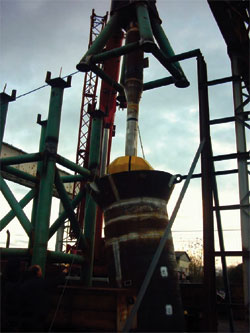 Technology from Europe: Technology from Europe:
France, Germany
Elastomerics for flexible joints offshore Africa
Oil offloading lines for the Girassol project (Total-Angola) required specialized flexible joints. TECHLAM, based in Cernay, France, develops laminated elastomeric components for offshore, defense, space and rail industries. Since mid-2005, it has been part of the Hutchinson Group – a worldwide leader in rubber-to-metal bonded products.
 |
Rosa field: Latching test, 10°.
|
|
The company delivered the first Oil Offloading Lines (OOLs) Flexible Joints in December 2001. Since then, it has received six other contracts for similar work: Kizomba A & B, EHRA (ExxonMobil), Greater Plutonio (BP) and Agbami (Chevron), representing 100% of OOLs applications in West Africa. In addition, the company has won four contracts related to Single Riser and/or Riser Tower Connectors: Kizomba A & B (ExxonMobil), Rosa (Total) and BP’s Greater Plutonio (see photos).
Flexible connections employ the laminated rubber component concept widely used in industrial applications, such as anti-vibration mounts, shock absorbers and elastic couplings. This involves bonding multiple rubber layers to metallic- or composite-reinforcement shims. The rubber’s low-stiffness permits a level of shear deformation under a small compression load, while the shims increase the entire component’s compression stiffness.
The end product ensures a flexible connection between two rigid assemblies. This can also endure both vertical and horizontal loads, maintain fluid tightness and withstand high-temperature or aggressive-fluid effects. Suitable deepwater applications include flexible joints and latching systems for hybrid riser systems and TLP tendon connectors.
Each layer of the laminated rubber is subjected to compressive loads caused by tensioning of the riser or tendon, shear loads at the rubber layer edges, and further shear loads induced by displacement of the end connections or shims (caused by floater/ riser interaction). The flexible connection can rotate at up to 22° in all directions, with low torque, thereby limiting stiffness and also fatigue in the riser or tendon.
For safety purposes, the rubber material must sustain a minimum 400% shear at break (for a 1-MPa shear modulus) and an appropriate fatigue resistance for the operating temperature range- – this varies from 4°C at the seabed (Riser Connectors) up to 130°C in production risers (Flexible Joints). Risers are also prone to fast pressure drop, so the potential for explosive decompression inside the rubber must be taken into account. This can be brought on by sudden eruption of diffused gas bubbles, which leads to blistering of the rubber. Contact with drilling mud or pigging equipment may create erosion damage in the rubber.
The company is presently implementing a full-scale fatigue test for its new, proprietary, Fail Safe Double Barrier flexible-joint concept (FSDB), dedicated to live oil and gas production applications. 
|

 Technology from Europe:
Technology from Europe:

